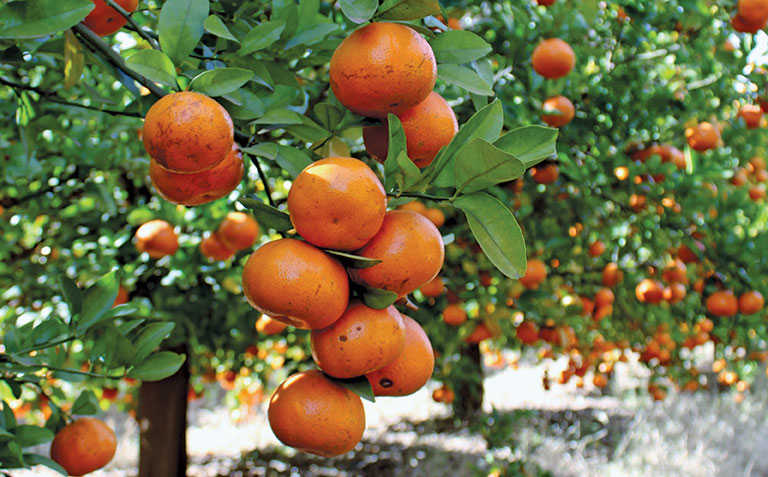
Photo: Lindi Botha
Differentiating one product from the next in a flooded fresh fruit market is the way to ensure long-term sustainability. But in the early 2000s, branding and marketing a specific fruit cultivar seemed far-fetched in a market dominated by the humble naartjie.
It was then that Citrogold, a company in the ANB Investments group involved with identifying, evaulating, developing and commercialising new citrus cultivars, procured the South Africa cultivar rights for the Moroccan-developed Nadorcott mandarin.
READ Why farmers need to be marketeers
But they had a tough time trying to get farmers to buy into the concept of a closed- cultivar mandarin that would be marketed independently.
Abs van Rooyen, CEO of ANB Investments, the holding company for ClemenGold and a former director of Citrogold, worked particularly hard to convince them. With a nursery full of trees ready to be planted and no one buying into the idea, he resolved to establish his own Nadorcott orchards and prove the quality of the cultivar.
His persistence paid off: today, in addition to his own ClemenGold-producing farms, there are more than 100 growers producing these mandarins, several for the ClemenGold brand.
There is also a lengthy waiting list of farmers wanting to be part of the story.
Branding of cultivars
The concept of citrus cultivar branding is gaining momentum. Recently, Outspan launched its Outspan Gem brand to compete in this segment of the market.
Marius du Plessis, CEO of ClemenGold, stresses that consistent application of quality standards is crucial to success.
“Factors such as colour, flavour, taste, acidity, sugar and seed levels must always be within a certain range. A brand should give the consumer the assurance that their eating experience is the same every time,” he says.
The proof is in the figures, with ClemenGold in-store tastings in Woolworths showing an 80% conversion to sales.
Beyond marketing
ANB Investments owns the ClemenGold brand. The group also owns a number of farms, Indigo Fruit Farming, the Naranja packhouse, which specialises in soft citrus, and cultivar development and management company Citrogold.
Its Du Roi and Cederberg nurseries develop the plant material.
Much of the company’s success is due to having a full range of services, from licensing the cultivars and providing the trees, to packaging, developing markets and marketing the fruit across the globe.
READ Good marketing knowledge key to fresh produce profits
ANB Investments works with farmers in several countries, including Australia, Morocco and Spain, to procure fruit of the right quality so that the market availability of ClemenGold can be extended as far as possible. Today, the produce can be purchased almost year-round.
Buy-in from supermarkets has been integral to the success of ClemenGold, and the company has entered agreements with high-end supermarket groups to stock the fruit exclusively.
The benefits work both ways, as the fruit is positioned in the right market and the stores attract customers who shop for this specific brand. In South Africa, ClemenGold is available only at Woolworths.
Last year, the cultivar had the third-highest sales of all food sold in this group’s stores during the peak citrus season.
As each market has different size and colour specifications, ANB’s high-tech packhouses are geared towards sorting the fruit to conform to each customer’s requirements.
Cultivar management
Managing closed cultivars is a balancing act between maintaining value for the grower and the consumer paying a premium for the brand.
Citrogold CEO Dr Viresh Ramburan explains that cultivar management involves identifying new cultivars that stand out from the rest, establishing the statutory rights (plant breeders’ rights) for the cultivars, and directing how, where and when they are planted.
“We take care of the cultivar registrations in the different countries, which can be a long and expensive task,” he says. “Plant breeders’ rights are a form of intellectual property that can be owned and licensed for use by growers on certain terms. We look at which areas are in production at which times of the year, so we can try to match supply and demand.
“We choose the climatic areas where the fruit will do well, license the rights to growers who share our values, and then build models on how to take the product to market. Once the cultivars are doing well, we ramp up production.”
With coordinated branding, the farmer has the benefit of leaving the marketing up to the experts, capitalising on extensive advertising campaigns that focus on creating a high demand for the brand.
According to Ramburan, the chief benefit of planting closed cultivars is that farmers have a better chance of securing a premium market for their fruit because the licensing company limits the number of hectares to keep it in line with supply and demand.
“Often, with a new variety, the demand is low, and it takes a few years to establish a steady market. In 2003, we started with 500ha of Nadorcott, increasing to 1 000ha in 2008 and 3 500ha in 2013, all keeping in line with market potential. It is crucial to retain value through the expansion period.”
A farmer’s perspective
ClemenGold grower Charles Rossouw, owner of Roslé Boerdery in Groblersdal, believes the nature of mandarins necessitates cultivar branding.
“The market is flooded with mandarins, so as a rule they don’t get a premium. Open cultivars can work with certain kinds of citrus, but with mandarins it’s a different story.
“If the produce from my farm is only on the market for four to six weeks, it would make no sense for me to do any marketing on my own to gain a higher price. By the time the consumer has bought into the idea, my shipment is already out of the market and I essentially have done the marketing for the next person.”
Rossouw explains that the more mandarins come onto the market in peak season, the greater the problem becomes of finding a market and getting a good price.
“Because I am a price-taker, I must be able to control my input costs and ensure that what I do produce has a market. ClemenGold has succeeded in organised marketing on a global scale.
“Now my fruit slots into a bigger programme for which there’s always demand because the fruit is sourced all over the world and there is always supply.”
He notes that while there is a small premium in selling the fruit as part of the ClemenGold brand, the benefit lies mainly in the fact that there is a more predictable demand for what he is producing.
“The rate of sale is high because there is demand created by huge marketing campaigns. At this stage, there are few fruits with brand recognition that are sought after by the consumer on this scale.”
Brand expansion
Much of the marketing focus is on exposing new consumers to the brand through in-store tastings, promotional campaigns and new product development, which all link back to the fruit itself.
This includes ClemenGold Gin and ClemenGold Juice. As the popularity of ClemenGold has increased, both the holding company and Woolworths have capitalised on the brand by creating value-added products.
The success of ClemenGold is paving the way for other branded citrus cultivars being released by ANB Investments, such as NavelGold, LemonGold and HoneyGold. The company is looking to expand the model to exotics, with its first focus on mangoes.
“It gives us the opportunity to expand the brand and include different kinds of citrus in our product offering to each supermarket,” says Du Plessis.
Email ANB Investments at [email protected], or phone 021 883 9723.










